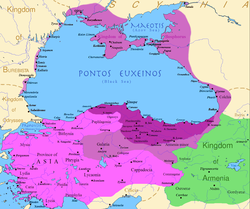Kingdom of Pontus
| Kingdom of Pontus | ||||||||||
| Client of the Roman Republic and Roman Empire (66 BC–62 AD) | ||||||||||
|
||||||||||
|
The Kingdom of Pontus at its height: before the reign of Mithridates VI (dark purple), after his early conquests (purple), and his conquests in the first Mithridatic wars (pink)
|
||||||||||
| Capital | Amaseia, Sinope | |||||||||
| Languages |
Greek (official) Old Persian (native and regional) Laz (regional) Pontian (regional) |
|||||||||
| Religion | Syncretic, incorporating Greek Polytheism with Anatolian and Persian gods. | |||||||||
| Government | Monarchy | |||||||||
| Basileus | Mithridates I Ktistes 281 – 266 BCE | |||||||||
| Ariobarzanes 266 – 250 BCE | ||||||||||
| Mithridates II c. 250 – 220 BCE | ||||||||||
| Mithridates III c. 220 – 185 BCE | ||||||||||
| Pharnaces I c. 185 – c. 170 BCE | ||||||||||
| Mithridates IV c. 170 – 150 BCE | ||||||||||
| Mithridates V Euergetes c. 150 – 120 BCE | ||||||||||
| Mithridates VI Eupator 120 – 63 BCE | ||||||||||
| Pharnaces II 63 – 47 BCE | ||||||||||
| History | ||||||||||
| • | Founded by Mithridates I | 281 BCE | ||||||||
| • | Conquered by Pompey of the Roman Republic, remained as a client state. | 66–65 BCE | ||||||||
| • | Annexed by the Roman Empire under Emperor Nero. | 62 CE | ||||||||
|
||||||||||
| Today part of |
|
|||||||||
The Kingdom of Pontus or Pontic Empire was a state founded by the Persian Mithridatic dynasty, which may have been directly related to Darius the Great and the Achaemenid dynasty. The kingdom was proclaimed by Mithridates I in 281 BCE and lasted until its conquest by the Roman Republic in 63 BCE. It reached its largest extent under Mithridates VI the Great, who conquered Colchis, Cappadocia, Bithynia, the Greek colonies of the Tauric Chersonesos, and for a brief time the Roman province of Asia. After a long struggle with Rome in the Mithridatic Wars, Pontus was defeated; part of it was incorporated into the Roman Republic as the province Bithynia et Pontus, and the eastern half survived as a client kingdom.
As the greater part of the kingdom lay within the immense region of Cappadocia, which in early ages extended from the borders of Cilicia to the Euxine (Black Sea), the kingdom as a whole was at first called 'Cappadocia by Pontus' or 'Cappadocia by the Euxine', but afterwards simply 'Pontus', the name Cappadocia henceforth being used to refer to the southern half of the region previously included under that name.
Culturally, the kingdom was Hellenized, with Greek the official language.
The Kingdom of Pontus was divided into two distinct areas: the coastal region and the Pontic interior. The coastal region bordering the Black Sea was separated from the mountainous inland area by the Pontic Alps, which ran parallel to the coast. The river valleys of Pontus also ran parallel to the coast and were quite fertile, supporting cattle herds, millet, and fruit trees, including cherry (named for the city of Cerasus), apple and pear. The coastal region was dominated by Greek cities such as Amastris and Sinope, which became the Pontic capital after its capture. The coast was rich in timber, fishing, and olives. Pontus was also rich in iron and silver, which were mined near the coast south of Pharnacia; steel from the Chalybian mountains became quite famous in Greece. There were also copper, lead, zinc and arsenic. The Pontic interior also had fertile river valleys such as the river Lycus and Iris. The major city of the interior was Amasia, the early Pontic capital, where the Pontic kings had their palace and royal tombs. Besides Amasia and a few other cities, the interior was dominated mainly by small villages. The kingdom of Pontus was divided into districts named Eparchies.
...
Wikipedia

